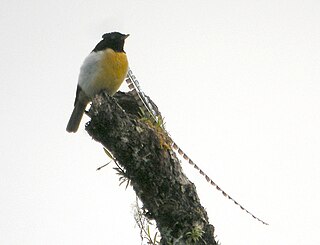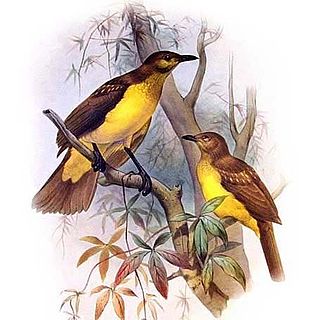This article needs additional citations for verification .(February 2024) |
Attenborough in Paradise and Other Personal Voyages is a DVD collection of seven David Attenborough BBC documentary specials. [1]
This article needs additional citations for verification .(February 2024) |
Attenborough in Paradise and Other Personal Voyages is a DVD collection of seven David Attenborough BBC documentary specials. [1]
The central area of New Guinea was thought to be uninhabited until aerial photographs showed signs of human habitation. Attenborough accompanies an expedition into the interior to find and make contact with these people and map the area.
Attenborough achieves a childhood ambition of finding and filming the birds-of-paradise described by Alfred Russel Wallace in his book, The Malay Archipelago . He visits New Guinea and surrounding islands to track down these birds. Their plumage, colours and mating dances are spectacular. The environment is so benign that the female birds can build their nests and raise their young without the help of males, so the females choose a mate on the basis of his beauty and dancing ability alone. As a result, sexual selection has produced the most incredible variety of extravagant displays imaginable....
A carved wooden idol that Attenborough purchased in an auction room is traced back to its origin: Easter Island. It was cheap because the seller believed it was a forgery. During the course of this programme its whole history is discovered: carved on Easter Island while there was still wood of the Toromiro tree (now extinct on the island), to represent the god Makemake, traded with the crew of captain Cook's ship, transported to Tahiti, probably traded by the Tahitians with the crew of an American whaling ship and ended up in the US.
Attenborough heads to Australia and New Guinea. Like the Birds of Paradise, Bowerbird females build their nests and raise their young alone so the male has all day to gather his treasures and create his bower. There seems to be a bowerbird rule: the more elaborate the bower the plainer the bird – the simpler the bower, the more vivid the plumage. David mischievously moves a leaf or a piece of lichen to see what the bird will do, then moves away. The bird flies back scoldingly and fussily returns his artistic display to its former perfection. Fascinating.
This natural history of music begins with Attenborough playing the piano. Searching for the origins of human music, he traces its connections to the musical sounds that other animals make: the beauty of the wolf's howl, the complexity of the bat's cry, the deep rumble of the elephant's signals, the acoustically sophisticated sounds the dolphin produces and the songs of whales and birds. Why do these animals produce this amazing variety of sounds? It's all tied up with sex and territory.
This BBC documentary traces David Attenborough's career. It is presented by Michael Palin and was first transmitted in 2002. It takes an in depth look at Attenborough's career in television: from his earliest application for a job with BBC radio, through his elevation to BBC Director of Programmes where they were kind enough to let him out of his suit every now and then to go and be intrepid, his rejection of the job of BBC Director General so that he could film Life on Earth .
Amber washed up on the shores of the Baltic Sea was given to Attenborough when he was 12 years old. He travels there to find out what that piece of amber has to tell about life in the forest where it bled from some sort of pine tree, trapping a community of insects as it oozed down the bark. Then a trip to the Dominican Republic, where amber reveals astonishing details about life up to 150-million years ago. In addition to insects, amber traps things like lizards, tadpoles, mammal hairs and seeds. Some of the perfectly preserved creatures have been scanned, X-rayed and tested for traces of DNA. The stories they tell are quite remarkable.

The birds-of-paradise are members of the family Paradisaeidae of the order Passeriformes. The majority of species are found in eastern Indonesia, Papua New Guinea, and eastern Australia. The family has 45 species in 17 genera. The members of this family are perhaps best known for the plumage of the males of the species, the majority of which are sexually dimorphic. The males of these species tend to have very long, elaborate feathers extending from the beak, wings, tail, or head. For the most part, they are confined to dense rainforest habitats. The diet of all species is dominated by fruit and to a lesser extent arthropods. The birds-of-paradise have a variety of breeding systems, ranging from monogamy to lek-type polygamy.

Bowerbirds make up the bird family Ptilonorhynchidae. They are renowned for their unique courtship behaviour, where males build a structure and decorate it with sticks and brightly coloured objects in an attempt to attract a mate.

The Trials of Life: A Natural History of Behaviour is a BBC nature documentary series written and presented by David Attenborough, first transmitted in the United Kingdom from 3 October 1990.

The Life of Birds is a BBC nature documentary series written and presented by David Attenborough, first transmitted in the United Kingdom from 21 October 1998.

The great bowerbird is a common and conspicuous resident of northern Australia, from the area around Broome across the Top End to Cape York Peninsula and as far south as Mount Isa. Favoured habitat is a broad range of forest and woodland, and the margins of vine forests, monsoon forest, and mangrove swamps.

The satin bowerbird is a bowerbird endemic to eastern Australia.

The King of Saxony bird-of-paradise is a bird in the bird-of-paradise family (Paradisaeidae). It is the only member of the genus Pteridophora. It is endemic to montane forest in New Guinea.

The green catbird is a species of bowerbird found in subtropical forests along the east coast of Australia, from southeastern Queensland to southern New South Wales. It is named after its distinctive call which sounds like a cat meowing, although it has also been mistaken for a crying child. The green catbird resembles the spotted catbird, which is found in wet tropical rainforests of Far North Queensland.

The Vogelkop bowerbird, also known as the Vogelkop gardener bowerbird, is a medium-sized bowerbird of the mountains of West Papua.

The magnificent bird-of-paradise is a species of bird-of-paradise. The magnificent bird-of-paradise is evaluated as Least Concern on the IUCN Red List of Threatened Species. They are listed in Appendix II of CITES.

The golden bowerbird is a species of bird in the family Ptilonorhynchidae, the bowerbirds. It is endemic to Queensland in Australia, where it is limited to the Atherton region.

The spotted catbird is a species of bowerbird (Ptilonorhynchidae) which can be found in north Queensland, the eastern Moluccas and New Guinea. Although it is a member of the bowerbird family it does not build a bower.

The regent bowerbird is a medium-sized, up to 25 cm long, sexually dimorphic bowerbird. The male bird is black with a golden orange-yellow crown, mantle and black-tipped wing feathers. It has yellow bill, black feet and yellow iris. The female is a brown bird with whitish or fawn markings, grey bill, black feet and crown. The name commemorates a prince regent of the United Kingdom.

The genus Ptiloris consists of four allopatric species of birds in the family Paradisaeidae. These birds of paradise are commonly known as riflebirds, so named for the likeness of their black velvety plumage to the uniform of the Rifle Brigade. Alternatively, the bird's cry is similar to a rifle being fired and hitting its target but a call like this is not commonly reported. They are distributed in the rainforests of New Guinea and Eastern Australia.

The fawn-breasted bowerbird is a medium-sized, up to 32 cm (13 in) long, bowerbird with a greyish brown spotted white plumage, a black bill, dark brown iris, yellow mouth and an orange buff below. Both sexes are similar. The female is slightly smaller than the male.

The yellow-breasted bowerbird also known as Lauterbach's bowerbird, is a medium-sized, approximately 27 cm long, bowerbird with a brownish-olive upperparts plumage, grayish-yellow upper breast, coppery crown, dark brown iris, yellow underparts, a black bill and pinkish-orange mouth. Both sexes are similar. The female exhibits less vibrant coloration than the male.

The spotted bowerbird is a sedentary, mid-sized passerine found across broad parts of the drier habitats of eastern Australia. The species is known for its remarkable behaviours, like many other bowerbirds (Ptilonorynchidae), which include bower building and decorating, courtship displays and vocal mimicry. Spotted bowerbirds are locally common, however, overall the population is thought to be in decline.

The western bowerbird is a species of bird in the family Ptilonorhynchidae. The species is a common endemic of Australia. It has a disjunct distribution, occurring in Central Australia and the Pilbara region of Western Australia.

Structures built by non-human animals, often called animal architecture, are common in many species. Examples of animal structures include termite mounds, ant hills, wasp and beehives, burrow complexes, beaver dams, elaborate nests of birds, and webs of spiders.

The masked bowerbird is one of the most brilliantly coloured bowerbirds. The male is a medium-sized bird, up to 25 cm long, with flame orange and golden yellow plumage, elongated neck plumes and yellow-tipped black tail. It builds an "avenue-type" bower with two side walls of sticks. The female is an olive brown bird with yellow or golden below.